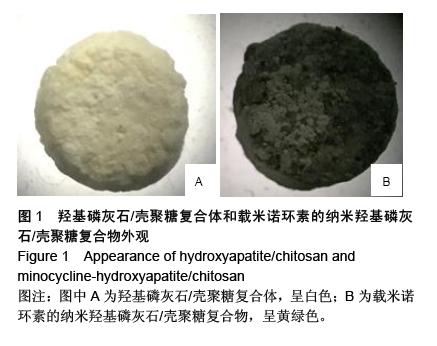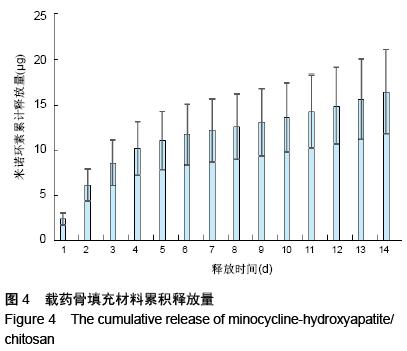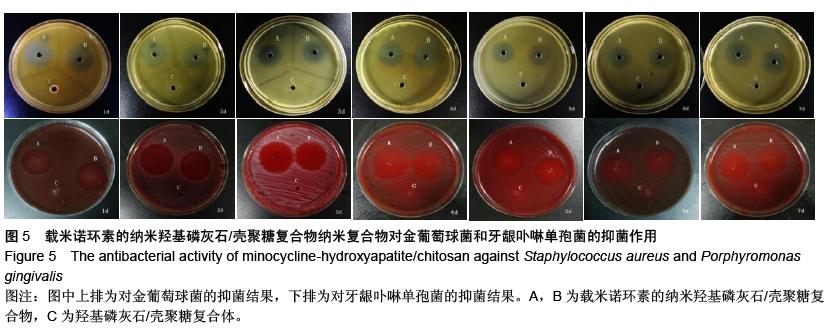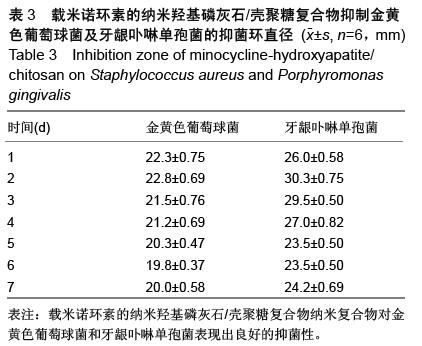中国组织工程研究 ›› 2016, Vol. 20 ›› Issue (8): 1118-1125.doi: 10.3969/j.issn.2095-4344.2016.08.008
• 药物控释材料 drug delivery materials • 上一篇 下一篇
载米诺环素纳米羟基磷灰石/壳聚糖复合体的体外释放及抑菌性
高昊辰1,汪 沛1,曹志中1,葛葵葵2,汪益涵3,陆 敏3
- 1解放军第二军医大学长海医院口腔科,上海市 200433;2复旦大学生命科学学院遗传学国家重点实验室,上海市 200433;3上海高科联合生物技术研发有限公司,上海市 201206
In vitro release and antibacterial property of minocycline hydroxyapatite/chitosan complex
Gao Hao-chen1, Wang Pei1, Cao Zhi-zhong1, Ge Kui-kui2, Wang Yi-han3, Lu Min3
- 1Department of Stomatology, Changhai Hospital, Second Military Medical University, Shanghai 200433, China; 2State Key Laboratory of Genetic Engineering, School of Life Sciences, Fudan University, Shanghai 200433, China; 3Shanghai High-Tech United Bio-Technological R&D Co., Ltd., Shanghai 201206, China
摘要:
文章快速阅读:
.jpg)
文题释义:
米诺环素:为半合成的四环素类抗生素,抗菌谱与四环素相近,具有高效和长效性,在四环素类中该品抗菌作用最强,可抑制大部分的牙周炎致病菌,目前临床上已有盐酸米诺环素成品注射在牙周袋内治疗牙周炎,但需要患者每周由医生指导下用药。作用机制是抑制细菌或其他微生物的蛋白合成,从而起到抑菌作用,可透过血-胎盘屏障进入胎儿体内,沉积在牙齿和骨的钙质区中,引起胎儿牙釉质发育不良,并抑制胎儿骨骼生长。
牙龈卟啉单胞菌:是一种非酵解糖的革兰阴性厌氧球杆菌,是证据充足的重要牙周致病菌之一。国外有学者研究发现37%的0-18岁个体中均可检测到牙龈卟啉单胞菌。除此之外,研究显示其还可能是引发心血管疾病和肺部感染等全身系统性疾病的危险因素之一。
背景:研究发现羟基磷灰石/壳聚糖复合体可作为药物载体起到缓释药物的作用,但目前缺乏将米诺环素载入该复合体后对其释放量及抑菌效果的研究。
目的:观察载米诺环素的纳米羟基磷灰石/壳聚糖复合体的体外药物释放及抑菌性。
方法:采用共沉淀法制备羟基磷灰石/壳聚糖复合体及载米诺环素的纳米羟基磷灰石/壳聚糖复合物。扫描电镜观察材料表面及断面特征;阿基米德原理测量材料孔隙率;以模拟唾液作为释药介质、高效液相色谱法测定盐酸米诺环素释放量;抑菌环法测量材料对牙龈卟啉单孢菌和金黄色葡萄球菌的体外抑菌作用,并通过CCK8细胞增殖实验评价载药材料的生物学毒性。
结果与结论:载米诺环素后,载米诺环素的纳米羟基磷灰石/壳聚糖复合物孔隙增大,平均孔隙率为53.99%;单日释放量可长期维持在0.5-1.0 μg/d,7 d后仍对牙龈卟啉单孢菌和金黄色葡萄球菌有明显的抑菌环;细胞增殖实验显示载米诺环素的纳米羟基磷灰石/壳聚糖复合物浸提液具有明显促进细胞增殖的作用。提示载米诺环素的纳米羟基磷灰石/壳聚糖复合物纳米复合物能够较长时间地持续缓释米诺环素,对于牙龈卟啉单孢菌和金黄色葡萄球菌均具有良好的抑制作用,并可促进牙周膜细胞的增殖。
ORCID: 0000-0002-4943-3451(高昊辰)




.jpg)


.jpg)